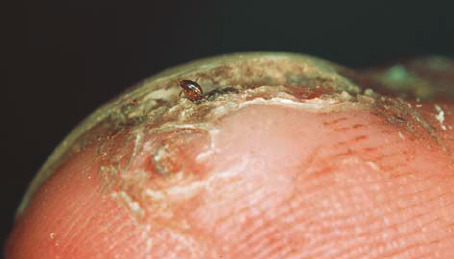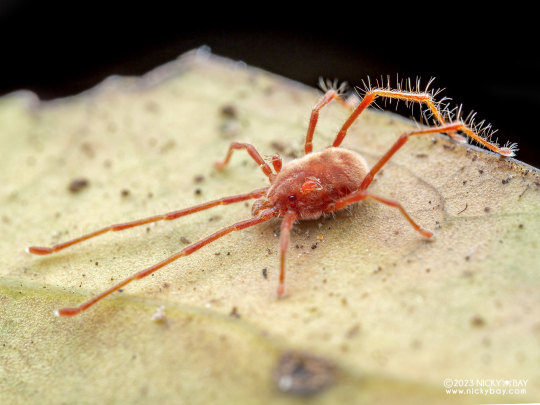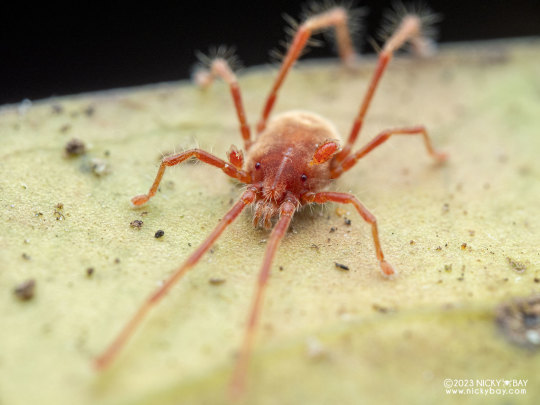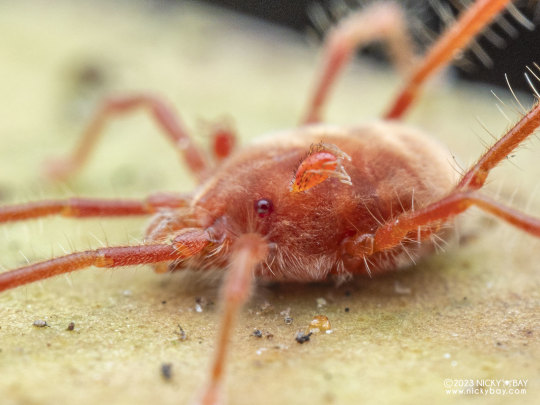#Siphonaptera
Explore tagged Tumblr posts
Text



Fleas and robberfly for Batter
#art#fanart#off game#off fanart#off the batter#the batter#robber fly#robberfly#fleas#siphonaptera#bugs#insects#diptera#bug off au
585 notes
·
View notes
Text
Uncharismatic Fact of the Day
To the naked eye, there isn't much difference between a grain of sand and the sand flea! Also known as jiggers or chigoes, sand fleas are the smallest species of flea in the world at only 1 mm (0.03 in) long, although they can grow up to 1 cm (0.39 in) once buried beneath the skin of their host.

(Image: A female sand flea (Tunga penetrans) by Jorg Heukelbach)
If you like what I do, consider buying me a ko-fi!
Under the cut: A bonus image of the sand flea on someone's toe (fair warning, it is a little gross)

Source: Jorg Heukelbach
#sand flea#jigger#Siphonaptera#Hectopsyllidae#fleas#insects#arthropods#invertebrates#uncharismatic facts
29 notes
·
View notes
Text
Taxonomy Tournament: Insects


Siphonaptera. This order is made up of fleas, small flightless insects that live as external parasites of mammals and birds, which feed on their blood.
Diptera. This order, known as the true flies, is made up of insects that fly using onle a single pair of wings. Members inclue fruit flies, houseflies, and mosquitos
#this one is kinda ''which clade is less bad''#animals#biology#polls#poll tournament#zoology#Animal parasite#fleas#arthropods#insects#ecdytes#flies#fruit flies#mosquitos#Siphonaptera#Diptera#0x1dv0xe2#animal tournament#Animal Tournament Round 1
45 notes
·
View notes
Text
not me putting my whole brain into a group presentation about siphonaptera that i wont even be a part of due to doctors orders to stay at home and rest
#and i even liked it yk#not so much the fact that i had to do it between 11:30pm and 1am#but the article was pretty interesting i loved it#and it was in english so i managed to practice my scientific terms knowledge#luh in her state of disgrace#siphonaptera#insects#arthropods#biology
4 notes
·
View notes
Text
being entomologist is also all about someone sending “my cat has fleas” in the bug group chat and everyone in there starts shouting CAN I HAVE THEM PLEASE. THE FLEAS I NEED THEM PLEASE PLEASE YOU DONT UNDERSTAND . MY GRADE
#clamtalk#it’s so funny we’re all so desperate for siphonaptera#PLEASE WE NEED MORE ORDERS FOR THE LOVE OF GOD!!!!#entomology#bugs#bugposting
19 notes
·
View notes
Text
gregor samsa's order
he's referred to as a dung beetle or roach most commonly, but solely off of opinion and vibes, what order do you think he was? open to any personal interpretations :)
#shiveringthoughts#shiveringreads#franz kafka#kafka#gregor samsa#the metamorphosis#taxonomy#entomology#bugs#insects#my ability to bring my special interest into everything is unmatched
21 notes
·
View notes
Text
"Oh we're just insects to-"
"Just" insects? Just insects?
Have some self respect!
No single clade of animal has killed more humans than insects!
So the next time some 'higher being' goes about its 'mysterious ways' around you, remember your place in the universe.
Jab your insignificant proboscis through it's ineffable dermis, gorge yourself on the delicious taste that only comes from buzzing beneath the notice of the transcendent, and leave it with the only thank-you note it'll notice, that exquisite itch that says:
'Thanks for the meal and enjoy the malaria.'
#melinoe labs#melinoe laboratories#so called higher powers#music#ai assisted art#ai music#random musings#mad science#unreality
32 notes
·
View notes
Text


⚔️ Abyssal Siphonaptera tokens on Patreon
- 🌟 Get access to more than 200 creatures, maps and assets by supporting us on Patreon! Complement your campaigns with hi-res monster tokens and start building the adventure of your dreams with our isometric assets 🏰!
#art#digital art#dnd#pathfinder#foundryvtt#dungeons & dragons#dnd creature#illustration#pathfinder monster#fantasy monster#level 10#beast#mutant#alien#bug#brute
9 notes
·
View notes
Text
Siphonaptera (poem) - Wikipedia
Great fleas have little fleas upon their backs to bite 'em, And little fleas have lesser fleas, and so ad infinitum. And the great fleas themselves, in turn, have greater fleas to go on; While these again have greater still, and greater still, and so on.[2]
-Augustus De Morgan
1 note
·
View note
Text
what species can digest blood..
Many species, including insects like mosquitoes and bedbugs, as well as some mammals like vampire bats, have evolved to digest blood, a practice known as hematophagy.
Here's a more detailed look:
Insects:
Arthropods:
A wide variety of arthropods, including Diptera (mosquitoes, flies, and biting midges), Hemiptera (bed bugs and assassin bugs), Phthiraptera (sucking lice), and Siphonaptera (fleas), are hematophagous.
Mosquitoes:
Female mosquitoes require a blood meal for egg production, and they are responsible for transmitting diseases like Zika, Dengue fever, and malaria.
Bedbugs:
All species of bedbugs are blood-feeding ectoparasites.
Other insects:
Sandflies, blackflies, tsetse flies, assassin bugs, ticks, lice, mites, midges, and fleas are also known to feed on blood.
Mammals:
Vampire Bats:
Three extant species of vampire bats (Desmodus rotundus, Diphylla ecaudata, and Diaemus youngi) are known to feed exclusively on blood, with adaptations like sharp teeth and anticoagulant saliva.
Other mammals:
Some other mammals, such as the oxpecker bird, also lap up blood from wounds.
Other Animals:
Leeches:
These segmented worms are known for their blood-sucking habits.
Lampreys:
These jawless fish have round, suction-disk mouths and teeth on their tongues to scrape through skin and access blood.
Vampire moths:
Some moths, like the vampire moth (Calyptra eustrigata), have evolved to feed on blood.
Snails:
Certain snails, like Colubraria muricata, are known to suck blood from fish.
0 notes
Photo
Siphonaptera
Great fleas have little fleas upon their backs to bite 'em, And little fleas have lesser fleas, and so ad infinitum. And the great fleas themselves, in turn, have greater fleas to go on; While these again have greater still, and greater still, and so on.
Augustus De Morgan, 1872





Long-legged velvet mite with parasitic mites attached, Callidosomatinae, Erythraeidae
Photographed in Singapore by Nicky Bay // Website // Facebook
Shared with permission; do not remove credit or re-post!
3K notes
·
View notes
Text
Uncharismatic Fact of the Day
Fleas are famous for their jumping abilities, able to leap anywhere from 50-250 times their own height and take off in only a millisecond! But they don't use muscles to accomplish these feats; instead they bend a part of their exoskeleton called the pleural arch, equivalent to a human rib cage. Then the arch is released, the pent-up energy is transferred into the flea's legs like an arrow being fired from a bow and the flea rockets into the air!
To learn more, check out this slo-mo video of a flea taking flight:
youtube
(Video description: a flea jumping off a surface in slow-motion from several different angles)
If you like what I do, consider leaving a tip or buying me a ko-fi!
63 notes
·
View notes
Text
Insects - Thinking Hats
White Hat
Taxonomy
Insects are a class of the Arthropoda phylum. They are actually the largest class in this phylum, with the Arthropoda phylum being one of the largest phylum under the animal kingdom.
Insects are classified as invertebrate multi-cellular organisms with a hard exoskeleton, segmented body, six legs, and generally one or two pairs of wings.
Insects generally have 3 segments: head, thorax, and abdomen.
Orders of insects:
Orthoptera - Grasshoppers, crickets and bush-crickets
Phasmida - stick-bugs
Plecoptera - stone flies
Dermaptera - earwigs
Dictyoptera - Cockroaches, termites and mantids
Embioptera - web-spinners
Grylloblattaria - rock crawlers
Mantophasmatodea - heel-walkers
Zoaptera - Zorapterans
Ephemeroptera - Mayflies or up-wing flies
Odonata - Dragonflies and damselflies
Hemiptera - true bugs
phthiraptera - Sucking and biting lice
Psocoptera - Booklice and barklice
Thysanoptera - thrips
Coleoptera - beetles
Diptera - true flies
Hymenoptera - ants, bees, and wasps
Lepidoptera - butterflies and moths
Mecoptera - scorpion flies
Megaloptera - alderflies
Neuroptera - lacewings
Siphonaptera - fleas
Raphidioptera - snakeflies
Strepsiptera - twisted wing flies
Trichoptera - Caddisflies/sedge flies
Life cycle and metamorphosis
Insects lay eggs to produce larvae. These larvae will go on to shed their exoskeleton several times over until adulthood. Some juvenile insects will change slightly after each moult and are referred to as nymphs doing this time. Other juvenile insects will only undergo large changes in their final moult (e.g: butterflies, moths). These insects often have an extra phase known as the pupa phase.
simple metamorphosis - the adult insect and juvenile insect differ very little in appearance, often the only thing separating the two is their size.
Complete metamorphosis - adult insects and their juvenile counterpart differ greatly in appearance. They often live in different habitats, and may have very different behaviour.
Dragonfly metamorphosis
Dragonflies undergo simple metamorphosis. First, females will lay eggs in gentle still water. The dragonfly larvae will hatch underwater and is actually where they will spend most of their life. They will spend their time as larvae for up to two years. When the larvae starts reaching its final moults, they will start to live on the edge of the water and learn to breathe air. Finally the juvenile will moult for the final time and emerge from their old shell body as a dragonfly. They will then live as a dragonfly for six months before dying.
Periodical Insects
some insects have a fixed life cycle length. In these species, adults appear at one time to reproduce for once in their lives and die. The larvae will often only hatch or reach maturity years later.
Cicadas are the most famous example of this and have the longest life cycle of insects. The nymphs will live underground and feed off of the roots of trees. Finally, after 17 years, they will emerge out of the ground. Over the next few weeks the cicadas will mate, lay their eggs, and die; repeating the cycle once more.
The may beetle is another example. Their life cycle lasts either 3 years or 4-5 years depending on the region.
Winter
Different species of insects have different ways of combating winter. One such way is through migration (eg: the monarch butterfly).
Some insect species will go through the process of 'overwintering.'
Many insects successfully pass the winter as immature larvae. The protection of heavy covers of leaf litter or similar shelters protect the woolly bear caterpillar, while other insects replace the water in their bodies with glycerol, a type of antifreeze! Some grubs simply burrow deeper into the soil to escape the cold.
Not many insects are active in the winter, but the nymphs of dragonflies, mayflies and stoneflies live in waters of ponds and streams, often beneath ice. They feed actively and grow all winter to emerge as adults in early spring.
Lesser numbers of insects lay eggs which survive the winter. The most prominent insects in this category are Praying Mantids, and the destructive Corn Rootworms also engage in this strategy.
Some insects overwinter in the pupal stage, then emerge as adults in the spring. Moths in the Silkworm Family, Saturniidae, may be found attached to food plant branches as pupae in the winter.
Insects also hibernate as adults. Ladybirds are a common example. Many large wasps seek shelter in the eaves and attics of houses or barns. Tree holes, leaf litter, and under logs and rocks are common shelters for overwintering adult insects. The Mourning Cloak Butterfly is usually the first butterfly that is noticed in the Spring, and this is because it hibernates in tree holes or other shelters during the winter. As in some insect larvae, it reduces the water content of its body, and builds up glycerol which acts as an antifreeze. Honey bees stay in hives during the winter, and form clusters when temperatures fall, vibrating their wings in order to create heat.
More info
They are one of the most successful group of animals in the world, with their populations far exceeding that of any other land fauna.
They are also the most diverse group of animals on Earth, with over a million identified species.
Insects have adapted to serval different climates, and have adapted to every land and freshwater habitat.
They play a crucial role in ecosystems as pollinators, decomposers, and food sources for other animals.
They have a complex social structure in some species, like bees and ants.
Their exoskeletons provide protection and support
0 notes
Text
Unraveling The Mystery Of Fleas Pest Control: A Comprehensive Guide
When fleas invade your living space, they are more than just a nuisance; they are persistent pests that require proactive management. Fleas, often associated with furry companions, can infiltrate homes with remarkable ease, inflicting discomfort and potential health risks. Effectively tackling these tiny but tenacious creatures demands a thorough understanding of pest control strategies tailored to combat flea infestations.
Understanding the Flea Phenomenon
Fleas Pest Control , small wingless insects of the order Siphonaptera, are formidable adversaries in the realm of household pests. Their agile bodies and specialized mouthparts facilitate the consumption of blood from hosts, including pets and humans. These adept jumpers can leap astonishing distances relative to their size, enabling swift movement between hosts and environmental surfaces.
Lifecycle of the Flea
To devise an effective pest control plan, one must grasp the intricacies of the flea lifecycle. Fleas progress through four stages: egg, larva, pupa, and adult. Eggs laid by adult fleas fall from infested hosts onto surfaces, where they incubate into larvae. These larvae thrive in dark, humid environments, such as carpet fibers or pet bedding, where they feed on organic debris. Subsequently, larvae spin cocoons and enter the pupal stage, from which adult fleas emerge ready to seek out hosts for sustenance.
Implementing Flea Pest Control Strategies
1. Sanitation
Maintaining a clean environment is paramount in flea management. Regular vacuuming of floors, furniture, and pet bedding eliminates flea eggs, larvae, and pupae, disrupting their lifecycle. Laundering pet bedding and frequently grooming pets also mitigates flea populations.
2. Chemical Treatments
Various pest control products are available to combat fleas, including sprays, powders, and spot-on treatments. These formulations often contain insecticides targeting fleas at different stages of their lifecycle. Consultation with a pest control professional can guide the selection of appropriate products based on the severity of infestation and environmental considerations.
3. Environmental Modifications
Manipulating the environment to deter fleas can complement pest control efforts. Installing dehumidifiers reduces moisture levels, creating an inhospitable environment for flea development. Additionally, sealing entry points and repairing screens prevents flea ingress from outdoor sources.
4. Natural Remedies
For those inclined towards natural alternatives, certain substances possess pest control properties against fleas. Diatomaceous earth, a fine powder derived from fossilized algae, desiccates fleas upon contact, rendering them ineffective. Similarly, essential oils like lavender and peppermint possess repellent qualities that discourage flea activity.
The Importance of Flea Prevention
Prevention is the cornerstone of effective flea management, sparing individuals and pets from the discomfort and potential health consequences of flea infestations. Regular grooming and inspection of pets facilitate early detection of fleas, enabling prompt intervention. Furthermore, administering flea preventatives, such as topical treatments or oral medications, safeguards pets against infestation.
Seeking Professional Pest Control Assistance
In instances of severe flea infestation or persistent challenges, enlisting the expertise of pest control professionals is prudent. These professionals possess the knowledge, experience, and resources to devise tailored flea management plans, effectively eradicating infestations and preventing recurrence.
Conclusion
Fleas pose a significant pest challenge, necessitating proactive pest control measures to safeguard homes and inhabitants. Understanding the flea lifecycle, implementing integrated pest management strategies, and prioritizing prevention are crucial steps in combatting flea infestations. By adopting a multifaceted approach and seeking professional assistance when needed, individuals can effectively manage flea populations and restore peace to their living spaces.
0 notes
Text
Since the numbers are readable, I'll try to reconstruct a caption, too. Mind that many of these relations were later disproven. † marks extinct organisms.
A. Single unspecialized cell B. Morula (a collection of unspecialized cells sticking together) C. Blastula (morula with the formation of an hollow space) D. Gastrula (invagination of the morula to form a proto-gut and proto-mouth) E. Opening of pores in the walls of a gastrula, leading to a proto-sponge F. Gastrula with tentacles, forming a polyp G. Formation of a coelom (organ-containing cavity) in a gastrula from masses of cells, proto-mouth forming the mouth H. Trochophora ciliate larva I. Formation of a coelom from gut pouches, proto-mouth forming the anus J. Dipleurula ciliate larva
Some simple protist that I can't quite recognize
Unicellular flagellate, possibly the parasite Giardia
Paramecium (ciliate)
Naked amoeba
Thecate amoeba
Foraminiferan
Heliozoan
Radiolarian (or maybe 7. Radiolarian and 8. Heliozoan? Not sure)
Flagellate alga, something like Chlamydomonas
Volvox (colonial alga) (the other arrow from 9 goes to plants)
Sponge, probably a Calcarean sponge
Sponge, probably a Demospongian
Sponge, probably a "glassy" Hexactinellid sponge
(I don't recognize this one)
†Archaeocyatha, an extinct sponge-like organism
Colonial hydroid
Probably a Siphonophoran related to the Portuguese man-o'-war? (Looks more like a Graptolith, but that should be closer to starfish)
Jellyfish
†Tabulate coral
Colonial coral (either Octocorallia or Hexacorallia)
Solitary coral, possibly †Rugose coral
Colonial coral (the other type than 20)
Ctenophoran (comb jelly)
Probably a Turbellarian flatworm
Cestoda (tapeworm)
Probably Nematoda (roudworm)
Hirudinea (leech)
Polychaeta (ragworm)
Oligochaeta (earthworm)
Rotifera
†Trilobite
†Chasmataspidida
†Eurypterida (sea scorpion)
Xiphosura (horseshoe crab)
Scorpiones (scorpion)
Araneae (spider)
Acari (mite)
Anostraca (fairy shrimp)
Copepoda
Ostracoda (clam shrimp)
Cirripedia (barnacle)
Phyllocarida
Syncarid
Decapoda (lobster)
Amphipoda (sandhopper)
Isopoda (wood louse)
†Aysheaia
Onychophora (velvet worm)
Myriapoda (centipede)
Thysanura (silverfish)
†Palaeodictyoptera
Hemiptera? ("true bugs")
Orthoptera (grasshopper)
Phthiraptera (louse)
Lepidoptera (butterfly)
Coleoptera (beetle)
Hymenoptera (wasp)
Siphonaptera (flea)
Diptera (fly)
Polyplacophora (chiton)
Bivalvia (clam)
Prosobranchia (sea slug)
I don't recognize this one
Nudibranchia (sea slug)
Pulmonata (snail)
†Orthoceratida
Nautiloidea
†Ammonoidea
Coleoidea (squid)
Inarticulate brachiopod (Lingula)
†A presumably extinct brachiopod I don't recognize
Articulate brachiopod (Terabratula?)
Phoronida or Bryozoa
†Homalozoa (Cothurnocystis)
†Another Homalozoa
Crinoidea (sea lily)
Asteroidea (starfish)
Echinoidea (sea urchin)
Holothuroidea (sea cucumber)
Hemichordata (acorn worm)
Chaetognatha (arrow worm)
Tunicata (sea squirt)
Cephalochordata (lancelet)
†Pteraspidomorphi (Anglaspis)
Cyclostomata (lamprey)
†Placodermi (Bothriolepis)
Chodrichthyes (shark)
†Early Actinopterygian
Chondrostei (sturgeon)
Holostei (alligator gar)
Teleostei (mackerel)
†Eusthenopteron
Dipnoi (lungfish)
†Temnospondyli
Lissamphibia (newt)
Anura (frog)
Testudinata (tortoise)
†Ichthyosauria
Crocdylia (crocodyle)
Squamata (lizard)
Squamata (snake)
†Dinosauria (Triceratops)
†Pterosauria
†Therapsida (Biarmosuchus?)
Aves (seagull)
Monotremata (platypus)
Marsupialia (kangaroo)
Chiroptera (bat)
Rodentia (squirrel)
Artiodactyla (gazelle)
Carnivora (jaguar)
Cetacea (orca whale)
†Plesiadapis
Hominidae (chimpanzee)
Hominidae (human)

"Chart of Evolution" by Borgny Bay (1937), Paleontological Museum, University of Oslo.
8 notes
·
View notes
Text
ROUND 1 OF THE TUMBLR INSECT POLL

95 notes
·
View notes